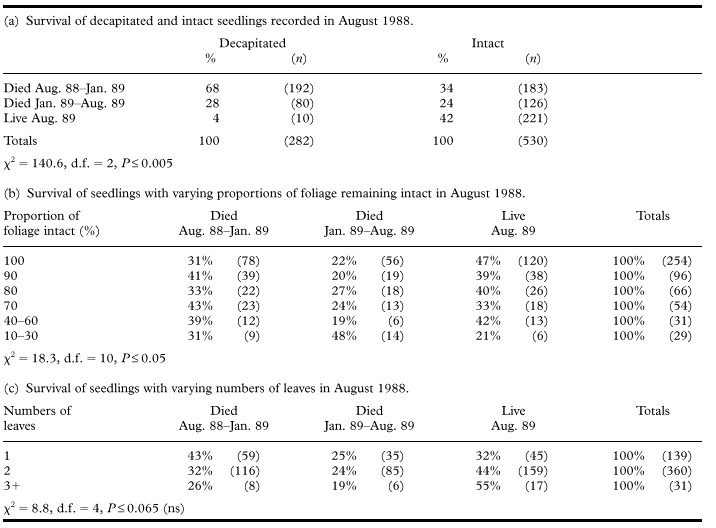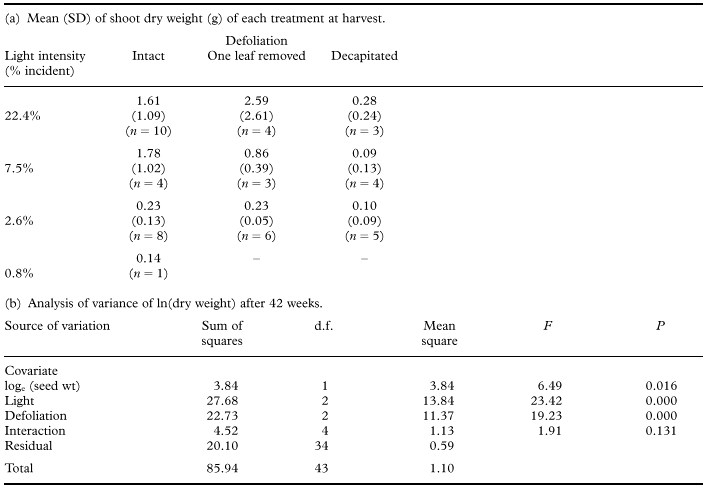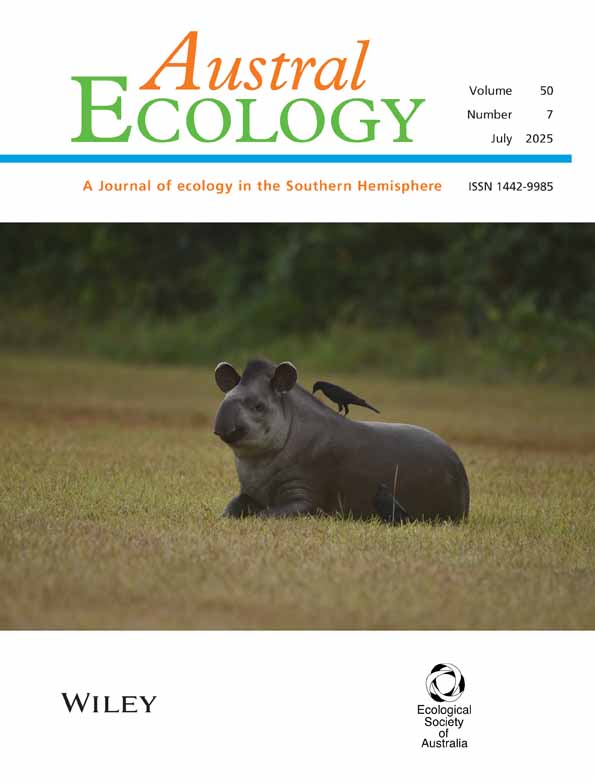Recruitment and survival of Argyrodendron actinophyllum seedlings in an Australian rainforest
Abstract
The capacity of seedlings to survive for extended periods beneath intact forest increases the likelihood of regeneration of many species of canopy trees in rainforests. I studied the demographics of Argyrodendron actinophyllum (F.M.Bail.) H.L.Edlin seedlings in a subtropical rainforest in northern New South Wales. A mast seeding of A. actinophyllum was observed and subsequent survival of seedlings monitored over a four year period. Densities of seedlings that emerged correlated with seedfall, while seedfall depended on the size and distance to the surrounding trees. Mortality of seedlings showed density-dependence at higher seedling densities (above about 100 seedlings m−2), apparently in response to browsing pressure that varied with the density of seedlings. Seedlings that were protected from vertebrates by exclosure cages had lower mortality rates than unprotected seedlings and showed no density response. Glasshouse experiments showed seedling growth was reduced by defoliation, light intensity and initial seed weight, and that seedlings could not persist at light intensities below about 1% ambient, which occur in darker patches on the forest floor. Possible mechanisms whereby the observed spatial and temporal patterns of seedling recruitment could reduce the likelihood of the species becoming more common relative to other tree species in the forest are discussed.
INTRODUCTION
The capacity of seedlings to persist on the forest floor appears to be important in the regeneration processes of many rainforest trees. The majority of species have large seeds not capable of extended storage in the canopy or the soil seed bank. However, these seeds can germinate beneath an intact canopy and persist for extended periods as seedlings or juvenile plants. A canopy disturbance that creates a gap would smother some seedlings beneath fallen debris, but others could respond to the sudden increase in light (Popma & Bongers 1991). In tropical rain forests most of the saplings growing beneath canopy-gaps originate as advance growth that was present prior to the appearance of the gap rather than as seed germinating in the gap (Uhl et al. 1988; Connell 1989). This is probably also true of subtropical rainforests (Olsen & Lamb 1988). However, in comparison with extensive work on seedling dynamics in species-rich tropical (or neo-tropical) forests outside Australia (Hubbell 1980; Augspurger 1983a,b, 1984a,b; Clark & Clark 1984, 1985; Ashton 1988; Schupp 1988; Kitajima & Augspurger 1989; Howe 1990; Hubbell et al. 1990; Turner 1990; van der Meer et al. 1998), there have been relatively few studies of the demographics of tree seedlings in Australian rainforests. These include studies of selected species of seedling trees in tropical rainforests (Willson 1988; Osunkjoya et al. 1992) and seedling dynamics at a plant community level (Connell et al. 1984).
Much of the interest in seedling dynamics in species-rich tropical forests has been prompted by the notion that patterns of seedling recruitment may circumvent competitive exclusion to facilitate the coexistence of so many tree species. Mortality rates that are dependent on either the density of seedlings or their distance from conspecific trees could lead to a compensatory effect whereby recruitment of rare species is favoured over that of common species (Janzen 1970; Connell 1971). Evidence of density-dependent mortality in a range of tropical forests has led some researchers to consider compensatory mortality to be a potent force influencing species-coexistence (Clark & Clark 1984; Wills et al. 1997), but others maintain it has limited effect on tree species composition and is generally only measurable in some plant species in a given community (Hubbell 1979, 1980; Connell et al. 1984).
Other possible mechanisms whereby the patterns of seedling recruitment could influence species-richness of forests may involve patterns of canopy disturbance (Connell 1978; Denslow 1980), spatial patterns of dispersal (Green 1989, 1994), and temporal variability of recruitment (Chesson & Warner 1981; Leigh 1982). These possible mechanisms also require investigation.
The species-richness of subtropical rainforests, while not as high as that of tropical rainforests, is high enough to be interesting. Why do common tree species not increase in relative abundance and competitively exclude rarer species? I examined spatial patterns of trees and saplings, spatial and temporal patterns of recruitment and survival of forest floor seedlings, and the major causes of seedling mortality in an area of subtropical rainforest (Nadolny 1992).
This paper describes the recruitment and survival of seedlings of the most common tree in that forest, Argyrodendron actinophyllum, following a mast-seeding event. Mast seeding is the production of heavy seed crops by most plants of a particular species in some years together with poor or absent seed crops in other years. Mast seeding has been widely reported in rainforests as well as in other plant communities (Ballardie & Whelan 1986; Ashton 1988; Norton & Kelly 1988; Shibata et al. 1998). In Australian tropical and subtropical rainforests most canopy trees in primary rainforest mast seed, with large crops of seeds produced irregularly at intervals of two or more years (Floyd 1990).
External factors that result in the death of seedlings can be classified into five major groups: (i) lack of resources; (ii) attack by predators or parasites; (iii) interference by other plants; (iv) failure to establish obligate symbiotic relationships; and (v) chance events. Essential resources include water, light and mineral nutrients. Seedlings require a suitable microsite so that roots can reach a reliable supply of water and nutrients. However, I considered it unlikely that lack of mineral nutrients would significantly affect survival during the seedlings’ first two to three years because the seeds, being large, have substantial mineral reserves and the soil is relatively fertile (McArthur 1964). Availability of water is affected by topographic and edaphic factors (e.g. soil depth, organic matter content) as well as by competition with surrounding plants, but is likely to be most critical during dry periods. Variations in the incidence of light on the forest floor probably affect both growth and survival of seedlings. Predators and parasites likely to influence seedling survival include vertebrate browsers, invertebrate folivores, and fungal pathogens. Interference by other plants often involves competition for essential resources, but may involve allelopathy or some other process. Interference could be caused by either adult trees or other seedlings, and by either the same or another species. Aspects of the interference of seedlings by mature trees have been studied in subtropical rainforest using trenching experiments (Connell et al. 1984), but were not considered in this study. Failure to establish symbiotic relationships is unlikely to affect the pattern of survival over a relatively uniform site where the subject species is also the most common tree. Chance events that could result in seedling mortality include burial of seedlings by leaf litter or by soil washed down the slope or trampling by animals.
METHODS
Species and site descriptions
Argyrodendron actinophyllum is a spur-buttressed canopy tree that is prominent in subtropical rainforests in Australia. While A. actinophyllum is the most commonly used name for the species, the official New South Wales flora lists the species under its synonym, Heritiera actinophylla (Bailey) Kosterm. (Harden 1990). It grows in primary rainforest and produces irregular crops of winged, single-seeded fruits (samaras), which spin as they fall to the ground. The wing on a mature samara is about 4–6 cm long and the samara (henceforth called a seed) weighs 0.5–1.2 g. The species has a tendency to mast-seed with major seeding events often separated by six or more years (Floyd 1990). During 1987 I observed the species to be mast-seeding over a distance of more than 300 km from Mt Boss on the mid-north coast of New South Wales to the McPherson Range in southern Queensland. I monitored the seeding event and early survival of the cohort of seedlings that resulted from it in a rainforest plot at Dorrigo National Park.
In the field, most of seeds that fell to the ground germinated within a month. Germinating seedlings exude a pectin-like substance that absorbs water and forms a gel. Pectins are common in a range of rainforest plants (Milton 1991). As the gel dries it glues together leaf litter surrounding the seedling, creating a microenvironment more amenable to water conservation. The substance may also benefit the seedling’s water relations directly or have other, unknown functions. The primary root grows vigorously following germination. Seeds that had landed on the tops of rocks commonly grew roots longer than 5 cm before the seedling desiccated. The cotyledons function as storage organs and a pair of true leaves emerges several days after the root is initiated.
The study site was located in subtropical rainforest at Dorrigo National Park, about 6 km southeast of the township of Dorrigo, New South Wales (30°30′S, 152°45′E). The site was on the side of an east-facing slope on the escarpment at an altitude of about 700 m a.s.l. The site comprised an area of just over 1 ha on a terrace with relatively homogeneous slope, aspect and soils. Soil at the site is derived from basalt, and is classified as a chocolate soil in the Great Soil Group classification, and as Gn 4.11 according to Northcote’s (1979) classification. The cover of cobbles and amount of organic matter in the A horizon varies over the site, with the greatest proportion of organic matter at the upper edge of the terrace at the bottom of a steep incline.
The climate is temperate, but mild. Rainfall occurs throughout the year but with a maximum in summer and a drier period in late winter and early spring. Mean annual precipitation recorded at Dorrigo is 2000 mm. The study period commenced following a prolonged dry spell in 1986, and included periods of above average rainfall in the following years. Temperature extremes at the site are moderated by the surrounding forest. During the study, temperatures were generally 5–25°C, and never went below 0°C or above 30°C.
The study site contains complex notophyll vine forest (subtropical rainforest). Canopy trees ranged from 30 to 50 m in height. Buttresses and large lianas are prominent. All trees over 10 cm DBH on the study site (1.11 ha) were tagged, mapped, identified to species and their diameter measured. All saplings and shrubs of over 30 cm height on three 5 × 75 m transects running through the plot were also recorded. There were 37 species of trees and a total of 761 living trees with stems over 10 cm DBH. The floristics of the site correspond to ecofloristic province A1 in the Webb et al. (1984) classification. The dominant trees were A. actinophyllum and Dendrocnide excelsa (Wedd.) Chew. The largest D. excelsa tree on the site attained a girth of 10.5 m. The palm, Archontophoenix cunninghamiana (H. Wendl.) H. Wendl. & Drude, and strangler fig, Ficus watkinsiana Bailey, were conspicuous, but not numerically important. A climbing palm, Calamus muelleri H. Wendl. & Drude, and an erect palm, Linospadix monostachyus (Mart.) H. Wendl., dominated the understorey. The ground layer consisted of a scattered covering of ferns, but some areas were bare and only covered with leaf litter, cobbles and scattered seedlings of trees and vines. There are signs that the site was selectively logged, possibly for rosewood [Dysoxylum fraserianum (A. Juss.) Benth.] or red cedar [Toona australis (F. Muell.) Harms.]. This must have happened before 1927 when the area was reserved for nature conservation. When the study commenced the largest canopy gap in the study site was about 10 × 5 m. In November 1989, the top of a large Sloanea woollsii F. Muell. snapped, smashing some smaller trees and creating a canopy gap of ~ 25 × 20 m.
Birds are the most conspicuous animals in Dorrigo National Park and include dispersers and predators of seeds. The scratching and raking activities of larger birds, such as the brush turkey (Alectura lathami) and the superb lyrebird (Menura novaehollandiae) are important causes of disturbance on the forest floor. Wallabia bicolor is the most common larger macropod. Thylogale thetis shelters in rainforest but usually feeds on rainforest margins. Thylogale stigmatica usually feeds in the interior of the forest, on fresh and fallen leaves of woody plants, fallen fruits and other browse (Johnson 1983). Rodents (mostly Rattus fuscipes) are probably the most important mammalian predators of seeds on the forest floor.
Flowering and seedfall
Thirty seed traps, each with a collecting surface area of 0.053 m2 were placed on the upper part of the plot in November 1986 to measure the seedfall of A. actinophyllum and other species. Each trap consisted of a plastic bucket fitted with loosely strung 1.5 mm nylon mesh and holes drilled in the bottom, mounted on a small wooden stake, generally about 1 m high. The traps were distributed in the upper part of the plot by subdividing the area with a 10 × 10 m grid and placing a seed trap randomly in each grid cell. An additional seed trap was placed beneath a canopy gap (about 10 × 5 m) in the other half of the plot in September 1987; five more traps were scattered over that half of the plot in November 1987. The total sampling area ranged from 1.6 m2 for the period when 30 seed traps were set to 1.9 m2 when 36 traps were in place. The seed traps were emptied each month and collection of seeds continued until November 1989. The seeds and associated litter were placed in paper bags, air dried, weighed and sorted. The traps were checked for predation on several occasions by monitoring the removal of marked seeds. No marked A. actinophyllum seeds disappeared from the traps. Notes on plants that were flowering and fruiting were collected to supplement the seed trap data. Seeds that had been destroyed when they were found in the traps were not counted.
The pattern of seedfall should depend on the size and distance of neighbouring trees. Multiple regression was used to test how well the density of seeds falling in each trap could be explained by distances to the three closest A. actinophyllum trees and their size. Trees less than 40 cm DBH were excluded because inspection using binoculars indicated that they set few seeds. From allometric considerations, the quantity of seedfall is likely to be proportional to a discrete power of the girth of the tree, so measures proportional to girth, girth squared and girth cubed were tested. Harper (1977) observed that the density of wind-dispersed seeds falling at various distances from a tree decreased at a rate varying between the square and cube of the distance, so both distance squared and distance cubed were tested in the regression modelling.
Seed predation and germination
To measure the removal of seeds from the forest floor by animals, seeds were placed on the forest floor and the wing of each seed was marked with a permanent felt-tipped pen to distinguish it from other unmarked seeds. In December 1986 20 seeds were placed in a single batch; in October 1987 12 seeds were placed at each of six locations at least 20 m apart. Seeds in the two trials were inspected after 10 and after 7 days, respectively. Locations where the seeds had been placed were cleared, marked with a stake, and the area was thoroughly searched so any seeds washed or blown from their original position were likely to have been found.
Seeds were collected from the site in December 1987 to examine the effect of seed weight on germination and on height of newly emerged shoots. After weighing, the seeds were taken to a glasshouse, sown in individual pots and watered regularly. Shoot growth was measured after four weeks.
Dynamics of seedlings in permanent plots
A quadrat of 1 × 1 m was placed beside each of the 30 seed traps in the upper half of the plot, as well as the seed trap in the canopy gap. Each quadrat was marked with hardwood stakes at each corner. All angiosperm seedlings (< 30 cm height) and larger plants that were found in each of the 30 1 × 1 m quadrats adjacent to seed traps were measured and tagged with an individual number in March 1987. The identity, height, number of leaves, leaf scars and proportion of each leaf that was missing on each seedling was recorded. At seven subsequent visits up to August 1989, all plants were re-measured and new seedlings measured and tagged. Plants that had died or had disappeared were noted.
Factors affecting the survival of seedlings may vary either among individuals or between quadrats. Recorded factors that varied among individuals were defoliation, number of leaves and height. The effect of these factors on the proportion of seedlings surviving to each census was assessed using contingency tables. Factors that varied between quadrats were peak density of seedlings (March 1988), canopy cover, the proportion of the ground surface covered by rocks, the number of canes of climbing palms (Calamus muelleri), and the quantity of litter falling in the adjacent trap in the 1988 calendar year. Canopy cover was recorded photographically using a hemispherical lens during a cloudless day in November 1989. The camera was mounted 1 m above the ground on a tripod in the centre of each quadrat. The photographs were scanned and the images analyzed to determine the proportion of sky that was obscured by vegetation. The flux of light at each point was determined using a computer program, called CANOPY (written by J. Williams, T. Montgomery and I. Davies, Research School of Biological Sciences, Australian National University, Canberra, ACT), similar to that described by Turton (1988). The path of the sun during each month of the year is traced over a scanned image of vegetation cover and the quantity of incident solar energy is calculated for each month.
Exclosure experiment
Seven pairs of smaller quadrats (0.8 × 0.4 m) were set up to examine the effects of larger animals on the growth and survival of seedlings. One quadrat from each pair was selected at random and fitted with a wire mesh exclosure cage (mesh-size 4.5 cm diameter), which completely enclosed the quadrat at a height of about 50 cm. Each pair was < 1 m apart, and > 10 m from other pairs. Seedlings in these quadrats were tagged and assessed in same way as seedlings in the other quadrats (as outlined in the preceding section). Log-transformed seedling counts were analyzed using two-way analysis of variance, with time treated as a repeated measure.
Glasshouse trial
I conducted a glasshouse experiment to examine the effects of defoliation and light intensity on seedling growth and survival. Seeds collected from the study site were individually weighed, sown in pots and watered regularly. After four weeks seedlings were selected at random and grown at four light intensities, using different numbers of layers of shade cloth. The glasshouse was covered in shade cloth, so none of the seedlings were exposed to full sunlight. Measurements with a Gosen Panlux electronic lux meter showed that the luminosity of each group of seedlings corresponded to 22%, 7.5%, 2.6% and 0.8% of incident light, respectively. After 4 weeks the growing shoots and leaves of one third of the seedlings at each light intensity were removed to simulate browsing damage and another third of the seedlings had one leaf from their first pair of leaves removed. After 42 weeks the plants were harvested. Seedling height, total leaf area, shoot dry weight and root dry weight were measured. The effects of the treatments on seedling growth were analyzed using analysis of variance with seed weight as a covariate.
RESULTS
Flowering and seedfall
Seedfall from A. actinophyllum varied dramatically during the period of observation. From September to November 1986, an average of 9.4 seeds m−2 was recorded in the traps. In mid-March 1987 A. actinophyllum trees on the site began to flower profusely. Seeds began ripening in October, seedfall peaked in early November, and ceased by mid-December. During October–December 1987 the average cumulative density per trap was 516 seeds m−2, and the maximum density in one trap was 2278 seeds m−2. The number of trapped seeds varied greatly between traps (Fig. 1). The spatial pattern of seedfall was aggregated when compared with a Poisson distribution (χ2 = 644.5, d.f. = 28, P < 0.005). Argyrodendron actinophyllum trees on the site did not produce flowers or seed during the two subsequent years (1988 and 1989). Some seed was produced in late 1990 after monitoring of seedfall had ceased.
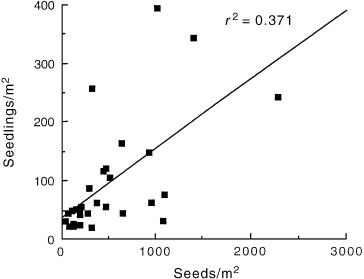
. Relation of density of seedlings of Argyrodendron actinophyllum emerging to density of seedfall.
Basal area of A. actinophyllum (proportional to girth squared) was a better predictor of seedfall than girth or girth cubed. Use of distance squared in the regression equation produced a better fit than distance cubed. The best prediction of seedfall was achieved using only the size of the first tree and distance to the third tree:
seed density = 442 + 0.0945 (basal area of 1st tree) – 2.35 (distance to 3rd tree)2 where r2 = 47.4%, (n = 29).
All coefficients were significant (Student t-ratios = 3.4, 4.8 and – 3.3, respectively). Mean distances to the first, second and third trees were 6.9, 10.3 and 12.9 m, respectively. The distance to the third tree is probably a better predictor of seedfall than the distance to the two closer trees because it conveys information about the distance of all three trees, and because the closest tree is generally so close that its distance is not important.
Seed predation and germination
All of the 20 seeds placed on the forest floor in December 1986 were removed within 10 days. In contrast, only 8% of seeds placed in October 1987 were removed in 7 days. It is possible some missing seeds could have been displaced rather than eaten. In addition to damage by vertebrates, a small proportion of fallen seeds was infested with Coleopteran larvae.
After 4 weeks in the glasshouse, 60% of the 208 seeds had germinated and most of the rest had died. The seeds that germinated were heavier, averaging 0.82 ± 0.02 g compared with 0.71 ± 0.02 g for those that failed to germinate (Student’s t = 3.96; P≤ 0.0001). Seed weights and the heights of shoots that had sprouted were correlated (r2 = 0.13, n = 108).
Dynamics of seedlings in permanent plots
Seedling emergence
The number of A. actinophyllum seedlings that emerged in the quadrats increased with the number of seeds that fell in the adjacent seed traps (Fig. 1). However, there was a wide scatter of points (r2 = 0.37, n = 29, with one trap damaged by a falling branch). During December and January there was a rapid turnover of seedlings. Seedlings died, or were decapitated by browsing animals, while other new seedlings emerged. The average density of seedlings emerging in a quadrat corresponded to 26% of the average density of seeds trapped (SD = 19.9%, n = 29).
Survival of seedlings
Mean densities of A. actinophyllum seedlings in the quadrats are shown in Fig. 2(a). The seedlings present at the initial census probably germinated following the 1986 seeding, but may have been older. The curve from March 1988 until the census in August 1990 is effectively a survival curve for a single cohort, since all the seedlings arising from seeds which had fallen in 1987 had already emerged and there were no further recruits during the following two years in quadrats where all seedlings had been tagged. Mortality was progressive: 79% of A. actinophyllum seedlings alive in March 1988 had died by January 1989, and 69% of the seedlings alive in January 1989 had died by February 1990.
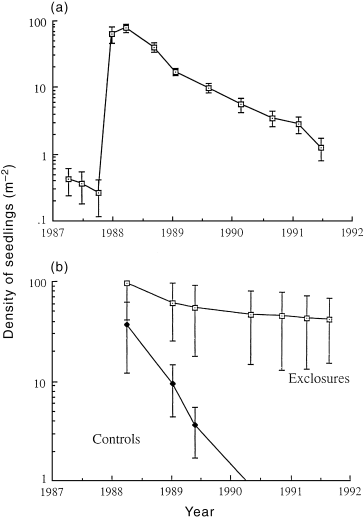
. Changes in the density of Argyrodendron actinophyllum seedlings. (a) In 31 permanent quadrats, each 1 m2; (b) In seven pairs of caged and adjacent uncaged quadrats, each 0.32 m2; error bars indicate standard error.
Defoliation influenced seedling survival. Tagged seedlings with tops bitten-off completely by browsing animals by the August 1988 census had lower survival to August 1989 than intact seedlings (Table 1a). Among seedlings with some leaf area remaining in August 1988, those more defoliated had lower survival to August 1989 than those less defoliated (Table 1b). The number of leaves on a plant was of less importance to survival (Table 1c). Partial defoliation was typically caused by insects, whereas vertebrate browsers generally removed entire leaves or the entire shoot. Complete removal of the aerial parts of A. actinophyllum seedlings (31.7% of 836) by browsing animals occurred more frequently than in other species of seedling trees (11.3% of 53).
Several other factors affected seedling survival. The mortality rates in each quadrat for periods 1–3 (March 1988–August 1988, August 1988–January 1989 and January 1989–August 1989, respectively) were compared with measured site factors using regression analysis. The calculated flux of light for each quadrat varied during the year, being lower in winter than in summer (Fig. 3). There was a correlation (r2 = 0.42) between the flux of light during winter (June, July, August) and over the entire year, but calculations of light flux for both periods were tested in the regression analysis. Significant relationships were found between site factors and mortality rates during period 2, the period of highest mortality, but not during periods 1 and 3 and only weak relationships were found for subsequent periods.
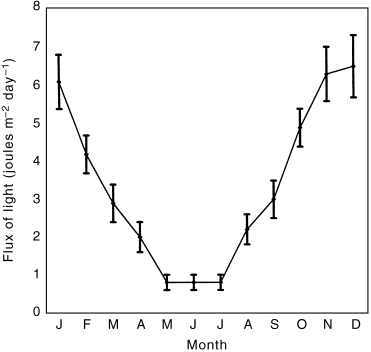
. Mean calculated flux of light (joules m−2 day−1) one metre above permanent quadrats (n = 31).
During period 2, peak densities of seedlings explained 49.7% of the variation of mortality rates between quadrats. Quadrats with high density had highest mortality (Fig. 4a). Calculated flux of light in the winter months, presence of rocks, quantity of litter falling, presence of canes of climbing palms and calculated annual flux of light all had no significant effect on mortality. There was no relationship between mortality rates and density when densities above 100 seedlings m−2 were excluded (r2 = 0.072, n = 22).
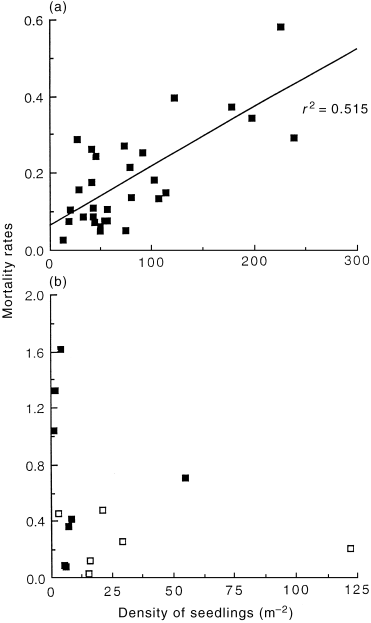
. Effects of Argyrodendron actinophyllum seedling densities on their mortality rates. (a) Seedlings in 1 m2 quadrats. Instantaneous mortality rates [m = (logeNt -logeNt+1)/▵t., where ▵t is given in months of 30.5 days] were for the period August 1988 to January 1989; peak densities were recorded in the March 1988 census. (b) Seedlings in seven exclosure cages (□) and adjacent control quadrats (▪), each 0.32 m2. Instantaneous mortality rates were for the period from January 1988 to October 1988; peak densities were recorded in January 1988. Mortality rates in three quadrats that had no remaining seedlings at the end of the interval were approximated by adding 0.5 seedlings to both the initial and final counts.
Density-dependent mortality probably resulted from denser patches of seedlings attracting browsing animals, chiefly macropods. A red-legged pademelon (Thylogale tigmatica) was regularly observed in the area, browsing the edge of dense patches of seedlings so that the size of patches gradually diminished. Mortality rates were probably more correlated with density of seedlings during the preceding period than density during the current period because browsed seedlings were counted as alive if any living part of the plant could be found, although they took about three months to die completely.
Rainfall during the period of study was above average, but there were dry spells, particularly in early spring. Excessive rain was directly responsible for some losses of seedlings. During autumn 1989 an intermittent stream flooded two quadrats. Mud buried some seedlings in three other quadrats in autumn 1989 and again in summer 1989–90. In December 1989 two quadrats were buried beneath debris from fallen trees, and the seedlings could not be located. Low incidence of light, pathogenic fungi and lack of water may all have contributed to further losses.
Exclosure experiment
Protection from browsing animals improved survival (Fig. 2b) with significant effects due to the treatment (P≤ 0.005), time (P≤ 0.001) and the interaction of time and treatment (P≤ 0.05). The variations in peak densities in the exclosures and matched controls were too low for a proper test of the relation between density and mortality rates in these quadrats (Fig. 4b). In each treatment only one quadrat had a density above 100 seedlings m−2. However, in the caged quadrat, where density of seedlings was greatest, mortality rates were consistently low: more than 32 months after the seeding event there were still 216 A. actinophyllum seedlings m−2, and other species of seedlings were also present. In this quadrat, most A. actinophyllum seedlings were still at the two-leaf stage, but one grew to over 50 cm in height. This illustrates the potential of rainforest tree seedlings to persist on the rainforest floor in the absence of vertebrates. The capacity of rainforest seedlings to persist at high densities is well known and a nursery practice of storing dense trays full of seedlings for propagation at a later date utilizes this capacity. While seedlings can recover from browsing, their chances of survival are clearly diminished. Other disturbances due to animals, such as raking of leaves by brush turkeys (Alectura lathami) and lyrebirds (Menura novaehollandiae), affect seedling survival but their importance has not been quantified. On sites where the surface of the ground was covered with stones, movements of animals appeared to damage seedlings by grinding the stones together.
Glasshouse trial
The analysis showed that light intensity and seed weight had a positive effect on seedling growth, and defoliation a negative effect. Interactions between the treatments were not significant (Table 2). The logarithm of shoot dry weight was used as the measure of plant growth, but other measures would have produced similar results because shoot dry weight correlated well with total dry weight (r2 = 0.98), root dry weight (r2 = 0.86), leaf area (r2 = 0.86), and height (r2 = 0.74).
Light intensity and removal of the growing shoot affected seedling survival. After 42 weeks, all but one of the seedlings grown at the lowest light intensity died. Almost all of the seedlings grown at the next lowest light intensity remained below 10 cm height, whereas seedlings grown at higher light intensities were commonly 20–30 cm tall. Removing one of the first pair of leaves did not affect survival and growth greatly, but 38% of seedlings that were decapitated (n = 42) had not sprouted again after 66 days. Of these, three sprouted by 229 days and two still had not sprouted, but were still alive, when the plants were harvested. The glasshouse was kept unnaturally warm during winter (about 25°C), so recovery in the rainforest may be even slower. The proportion of decapitated plants that sprouted was independent of light conditions. The sole surviving plant grown at the lowest light intensity was excluded from analysis. Several plants in other treatments died before harvest due to a malfunction of the glasshouse fan-heaters.
DISCUSSION
Variability of seedfall
The results indicate great variability in both spatial and temporal patterns of seedfall. Since the seeds are wind dispersed it is not surprising that nearly half the spatial variability in seedfall could be explained by measures of tree size and distance from trees. The rate of emergence of fallen seeds was high, being about 43% of that measured in the germination trials, but variations in emergence rates between quadrats suggested some quadrats were safer than others.
Patterns and causes of seedling mortality
The mortality rate of the seedling cohort appeared to vary over time. This could mean seedling mortality is age-dependent, density-dependent or simply that seedlings that germinated in poor microhabitats all died in the first few months after emergence, following an initial period when the seedling was maintained from food reserves in the seed.
The results of the exclosure experiment demonstrated the impact of vertebrates on survival of A. actinophyllum seedlings during the period of study. Vertebrates also had an impact on other species of seedling trees at the study site but removal of the aerial parts of A. actinophyllum seedlings by browsing animals was greater than in other species. The general effect of exclosure cages on the survival of rainforest seedlings was consistent with other findings. Connell et al. (1984) found exclosure cages improved short-term survival of Doryphora sassafras seedlings in a similar forest. Osunkjoya et al. (1992) found a similar response in a range of transplanted seedlings in rainforests in North Queensland. Howe (1990), working in Panama, also found seedlings protected from browsing by exclosure cages grew and survived markedly better. He found 70% of unprotected seedlings were completely defoliated during the first year and, while most recovered, their root development was retarded and many died during the dry season.
The needle-like prickles of Calamus muelleri may protect seedlings from browsing, but there was little correlation between the number of canes of climbing palms and mortality rates. However, number of canes may not be a good measure of the protection afforded by this plant. Alternatively, shading by climbing palms may reduce seedling survival and obscure any protective effect. There is some evidence from elsewhere relating the pattern of animal movements to seedling survival. Turner (1990) partly attributed better survival of Shorea curtisii seedlings in rainforest gaps to reduced predation by small browsing animals, associated with the presence of vine tangles. In contrast, herbivory of various seedlings is more intense beneath canopy gaps than in intact forest in Panama (Schupp 1988; Kitajima & Augspurger 1989; Howe 1990). There is a need to quantify such variations in herbivory in Australian forests.
Since the life-expectancy of seedlings is limited by browsing animals, it is probable that relative abundance of seedlings on the rainforest floor is influenced by changes in macropod populations. Published studies on responses of plants to removal of herbivores show consistent evidence that vertebrates affect species composition of regenerating vegetation (Crawley 1989). Increasing macropod densities could alter the spatial pattern of surviving seedlings, reduce overall seedling densities, reduce proportions of more palatable species and reduce survival rates of seedlings from any given cohort. This would reduce the period during which seedlings of trees that set seed irregularly are present on the forest floor. More needs to be known about fluctuations in populations of these browsing animals.
The results of the glasshouse test suggested low availability of light on the forest floor could shorten the life expectancy of seedlings. The results were consistent with those of other glasshouse studies of Australian rainforest seedlings (Stocker 1988; Olsen 1990; Turnbull 1991). Some caution is needed in extending the results of glasshouse experiments to a field situation since quality of light in a shaded glasshouse differs from that on a forest floor (Turnbull 1991). In particular, the forest floor light environment is dominated by sunflecks (Chazdon 1988). Estimated incidence of light was only partly correlated with survival rates of seedlings, but the correlation was greatest during winter when light was more likely to be limiting. Estimates of the incidence of light were only approximate because reflected sunlight from leaves could not always be distinguished from open sky and seasonal fluctuations in canopy cover and variations in the spectral quality of light were not measured.
Mortality associated with low light may be an indirect effect. Augspurger (1984b) found pathogenic fungi killed more seedlings when light was limiting. Fungi may have been involved in similar declines of shaded seedlings noted during the present study both in the glasshouse and on the forest floor.
Drought can also cause seedling mortality but the period of study included relatively few dry spells. However, seedlings were almost absent from the forest floor during a drought preceding the seeding event, and dry conditions during the first half of 1991 were associated with low seedling densities in general and relatively high mortality rates of A. actinophyllum seedlings in particular (Fig. 2). Unfortunately, by this time seedling densities were already too low to verify the effects of dry conditions. The relative importance of mortality versus reduced rates of emergence in contributing to the low seedling densities observed during dry conditions is uncertain.
The ecological importance of seedlings sprouting again after removal of their aerial shoots has not been fully explored. A high proportion of seedlings in both glasshouse and natural situations failed to recover from destruction of their leading shoots, but some seedlings may sprout again after an extended interval. Delayed sprouting could be ecologically important, if it allows some seedlings to withstand extended burial under debris associated with a treefall.
Density-dependence
The observed density-dependence of seedling mortality was probably a consequence of the behaviour of the vertebrate browsers. Browsing appeared to be more intense where the density of seedlings was high. However, the pattern of density-dependence was complex, so the conclusion is not unequivocal. Density-dependent mortality of Argyrodendron seedlings was evident during only one of the intervals for which mortality rates were assessed. For other intervals, only a small proportion of the variability of instantaneous mortality rates among quadrats was explained by measured factors, including density; and in the exclosure experiment density-dependence was not evident in either exclosures or exclosure controls. The best explanation for these inconsistencies is that density-dependence only occurred at high seedling densities, over 100 seedlings m–2, which did not occur at later time intervals and only occurred in one quadrat in the exclosure controls. However, it is difficult to extrapolate these findings to other forests and conditions.
The density dependent mortality of A. actinophyllum seedlings could be a case of compensatory mortality that operates on a small spatial scale (Connell et al. 1984). Mortality rates of seedlings belonging to other species intermingled with A. actinophyllum seedlings were probably less affected by density because a smaller proportion of those seedlings were browsed. Connell et al. (1984) found mortality rates of seedlings that were adjacent to a conspecific were greater than those of seedlings with other species as nearest neighbours. Density-dependent mortality of rainforest seedlings has been widely reported. Augspurger (1983a,b, 1984a) found density-dependency in a range of rainforest tree seedlings in Panama, notably Platypodium elegans, attributable to pathogenic fungi. Clark & Clark (1985) found damage to leaf and stem meristems of seedlings of Dipteryx panamensis in Costa Rica caused by insects was also density-dependent. Density-dependent mortality of seeds and seedlings has been reported in a range of plant communities other than rainforests (Antonovics & Levin 1980; Howe & Smallwood 1982; Wellington & Noble 1985; Crawley 1990). Currently there is insufficient evidence to prove a major role of density-dependent mortality in facilitating coexistence of species in subtropical rainforests (Connell et al. 1984), but the results reported here suggest it could be important.
Mast seeding
There are two possible explanations for mast seeding: (i) it is due to irregular occurrence of favourable conditions for production of flowers and fruits, or (ii) it is an evolved characteristic. There is some evidence that environmental conditions suitable for seed development do occur irregularly in rainforests; for example, flower bud development is arrested during dry spells (Borchert 1983). Other factors that affect rates of seed-set may compound this variability (e.g. competition for pollinators or rates of predation on developing seeds). For mast seeding to evolve there must be an economy-of-scale whereby it is advantageous for a tree to delay reproductive activity and then suddenly switch to it (Norton & Kelly 1988). Possible economies-of-scale could involve satiation of seed predators so some seeds are able to escape predation (Silvertown 1987) or greater chance of pollination (Norton & Kelly 1988). Both of these possibilities could apply to A. actinophyllum, which is a monoecious species, and, in the present study, was found to have low rates of postdispersal seed predation during the mast seeding year. Both of these possibilities require further investigation.
Significance of temporal variability in seedling abundance
The relative abundance of different size classes of A. actinophyllum showed marked variability (Fig. 5). About a third of large trees (over 40 cm DBH) on the site belonged to this species. In contrast, A.actinophyllum represented less than 3% of small saplings (0.3–3 m height), while it comprised an intermediate proportion of larger saplings and small trees. The proportions of tree seedlings belonging to the species ranged between 16% and 96.3% during the course of the study. A major canopy disturbance at a time when A. actinophyllum dominated the seedling pool would probably result in a higher proportion of sapling recruits of that species compared with a disturbance when the relative abundance of the seedlings was low. If species composition of regeneration following a disturbance reflects that of the existing seedling pool, a recent history of canopy disturbances coinciding with periods of low relative abundance of A. actinophyllum seedlings could explain the dearth of small saplings belonging to that species in the plot.
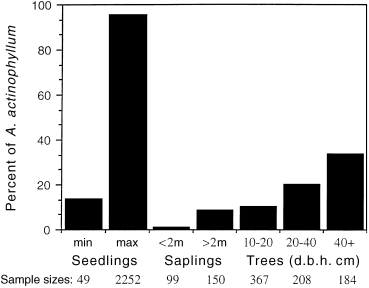
. Proportion of Argyrodendron actinophyllum in relation to other species of trees at various size classes. The minimum and maximum percentages of A. actinophyllum seedlings during the period of study are shown in the two columns on the left.
The observed temporal variability may be an important factor contributing to maintenance of species-richness in the forest. Chesson & Warner (1981) developed a lottery recruitment model that compares the recruitment of a single species with that of all other species in a community. They predicted that, in systems comprising long-lived individuals, relative fluctuations in recruitment, which alternatively favour recruitment of common species and rare ones, could help facilitate species coexistence by increasing long-term relative recruitment rates of rare species. Such a pattern of recruitment appears to be happening at the study site, at least with respect to A. actinophyllum.
Acknowledgements
This work was supported by a Commonwealth Postgraduate Research Award and an Ecological Society of Australia Student Travel Grant. Helpful suggestions and comments on early drafts of the manuscript were given by Joe Connell, Stuart Cairns, Hal Heatwole, Roger Kitching, Jill Landsberg, David Lamb. Various people assisted with field work, especially Rosemary Lott and Stuart Jackson. Ian Davies provided software for calculating flux of light from canopy photographs.



